
Merlin Carpenter
press release September 2022
an exhibition at Longtang, Zurich, September 2021
curator Tobias Kaspar
music STRESS II by Acolytes
steam by Steam
youtube(1)
I dream I walk the corridors of a hotel in Ibiza. At the moment I awake, I actually am walking the corridors of the hotel.

In 2013 I wrote a press release months after the show had already happened. It was for Support nightclub experience Nightclub in Porto.(2) This one is similar, but for a different reason. It is not that it was not ready, I actually did not want a proper press release at Steam Engine. This was the only press release available:
Room Sheet (press release coming soon)
There is no press release, but Steam Engine is based on ideas which can in the end be described and communicated.
This placeholder was it. Despite the lack of supporting material, and leaving things comfortingly "open-ended", I was trying to say that this was deliberate and there was in fact thinking behind the show, although this might have appeared to be a joke. Steam Engine was at the time meant to be light and convey its meaning without a press release – to be self-supporting. The project was not pushing to problematise anything, so the problem of what it was about could be pushed to another level. In that sense it started to respond to previous criticism of my work: that it is stuck in an older dialectic. Maybe this was a good moment to lower the levels of self-aggrandisement, for an OK Boomer artist to relinquish control to their empowered fans, or maybe to their younger self. And maybe it's cool to display a thinking that benefits from some errors, as a kind of self-proving ground. But the subjectlessness of the paintings and the lack of press release were also an invitation to a potential misunderstanding.
The opening was full of steam so you could hardly see anything, and there was music by Acolytes playing that sounded like a train right in the room.(3) Actually the steam in the room was the press release. Then and now, the closer I get to the press release the further away it gets. It was a feeling that I should just know what to do with it. Even now a year later it feels like a sort of automatic writing, in a stuttering style formed of the notes I made in 2019 while I worked on the paintings. And do people even read press releases? Who and why? Can a press release be considered an academic text, a part of a chain of thinking? Or is that too ambitious? These questions have plagued me for years.
Avoiding having a text does not really work. Or, this decision would only be a link point to something else. There might be a need to write a new text/press release, because the old ones are defunct. If just for myself it is essential to get beyond the strategies I proposed in my long 2015 text, these ideas being now rather discredited, though still interesting.(4) To disarticulate what I did before and rearticulate it in a new context, in an interminable theoretical discussion that proceeds by and through the disastrous and distracting world events of the last few years.
One factor here was that Longtang was a not a commercial gallery. It is easier to see that paintings are pure exchange when the exchange is not happening. Instead Tobias Kaspar and I decided to pretend it was an INSTITUTION. A place to do a show which plays with a "giving in" to painting, and start where I should not start, right in my own conservative links to Cologne in the 90s - the pathetic gingham pattern of the "Wachstücher" tablecloth material and its various regressive associations, from Italian trattoria to Munich beer hall, and staid stuffed collector shirts.
Various series of works made in my Berlin studio had led up to this exhibition. First, the 2018 stripe paintings shown with Overduin & Co. in Amsterdam. This involved moving their LA gallery to Amsterdam, because of Trump, in a kind of USA boycott. But it also involved me flying to LA immediately afterwards and doing a second installation there to promote the Amsterdam show, doubling and undercutting the "boycotting" gesture. I am aware now that this show simply could not be understood at the time. In the Trump period it felt like there was a rage-fuelled inability to think, it was a giant distraction machine. However, despite the mad doubling of the two city locations this was a "didactic" show. As such, rather difficult to get, like others I did between 2016 and 2020 leading up to Paint-It-Yourself and Circuits.
I've been working with diagrams in art for a while, originally in dialogue with Nils Norman, Stephen Willats and others. The next Berlin studio output was Circuits, black and white diagram-like paintings which were shown at dépendance in Brussels, and Circuits drawings shown at Palette Terre in Paris, both in 2020. Before the diagrams morphed into train wheels they were more basic. I imagined the circuit of capitalist value; a simple diagram of inputs and outputs, a two dimensional space, relatively uncomplex (and it is fundamentally fairly simple given all has to be reduced money and to the underlying abstract labour/surplus value). But these were damaged circuits that clearly would not work – they do not connect up and would not even light up a tiny lamp. What I was trying to picture is that there are other factors going on that are not "value" as such. They just do not actually appear on the capitalist value diagram. So the breaks you see in the circuit are those externalities which are not factored in: the obvious one being global heating; or political resistance; labour in its non-value concrete performance; or non-market uses of some other kind. They do factor but in a perverse way, they appear as jumps or breaks which might be visible as traces of absence, but in the end would be buried as the actual diagram of value shifts and re-assembles.
After establishing this, I went on to make diagrams of the The Far Right In the Art World, which ended up as a poster insert in Arts of the Working Class in 2019. The Steam Engine paintings are a culmination of this stark diagrammatic-programmatic work, but become didactic to the point of being arty again. This chain of previous studio and intellectual developments was referenced in the Zurich show by two posters hanging in the foyer.(5) I then moved from making a diagram of an imaginary far-right network in the interstices of the art world to drawing the interconnected wheels of a "steam engine" (more correctly called a locomotive, an engine being stationary).
Other starting points for this series included Trotsky's civil war propaganda train(6), bicycles, assemblages bolted together, machines by Fernand Léger, and other eco-unfriendly engines within the readymade. Under Marx's "real subsumption" workers become adjunct to the machine; the very nature of their labour power is altered. But what about when the machine – the steam engine – becomes a locomotive, and starts moving around under its own power? This would be the diagram in motion, adequate to the system which its object of concern: this system is also literally in motion. Ideology in motion. It's good being a train because I'm already a train. I am the workings of a steamroller, the steamroller man. A Snowpiercer that never stops at any platform.
A moving diagram represented by train wheels. I was proposing this as maybe a dodgy kind of metaphor for how the savage re-assembling of the value diagram becomes a kind of runaway train, both ideologically and politically. How all sort of other things start to go wrong when the diagram is not seen for what it is but functions as a starting point for policy or for opportunistic gangsterism, and the result of that as a starting point for something even worse.
By the time of Steam Engine at Longtang I was thinking a half step further on. At first it was about the movement of the diagram, and how that became a narrative that was hard to pin down. Then I started thinking about someone looking down on the two dimensional diagram, from ninety degrees. This person imagines they have a privileged view, a detached interpretation, in on the knowledge – something we are very familiar with on social media. Everyone imagines they have the interpretative key, the view from outside. But this top down view is itself rather short-circuiting or even fascistic, and it replaces the more difficult work of reconstructing what has built up this diagram in the first place (labour in class struggle). Instead only the effects of this process are seen, despite, or perhaps because of, the continuous reconfiguration or loco wheel-like "movement". A Polaroid-picturing of a moving situation – so I started to think about picturing this picturing itself, using the absurd metaphor of the steam-filled room...
In the Circuits Press Release in early March 2020 I wrote: "Even the 'reality' of labour is an abstraction, a mediation. You can't 'get to it', it can't even get to itself."(7) In other words even for the actual worker the nature of their labour is obscured. Yet, a few weeks afterwards, by the end of the same month, my claim was undermined. It turned out that in lockdown, with time "stopped" yet labour – recategorised as "essential" – still going on, it became possible to "see" it. Like the cross section of class war, the pandemic was the collective panorama of a crisis that was already going on. Perception froze in March 2020 and workers got a rare view of the counter-revolution, of how what work is essential must normally be kept hidden. There is always a movement, you just need to be in it to see in. Though fleeting, this perception was a mass phenomenon. And things move fast in stopped time – shortly after you had the BLM-led street revolution in the USA in Summer 2020, which asked what must be abolished.
This sudden new solidarity can be referred back to but it can't be reproduced. It implies a view on the stopped diagram – a "stopped" motion because always returning to the same motion. Normally a dynamic, viewerless picture, it can only be seen in moment of a cut. The pandemic is a portal, it is brain fog, but the mist will suddenly lift to reveal the new diagram. The obscured visible, an impossible or perhaps almost impossible view. Can you see something while not seeing it, see the coming reality in the old reality?
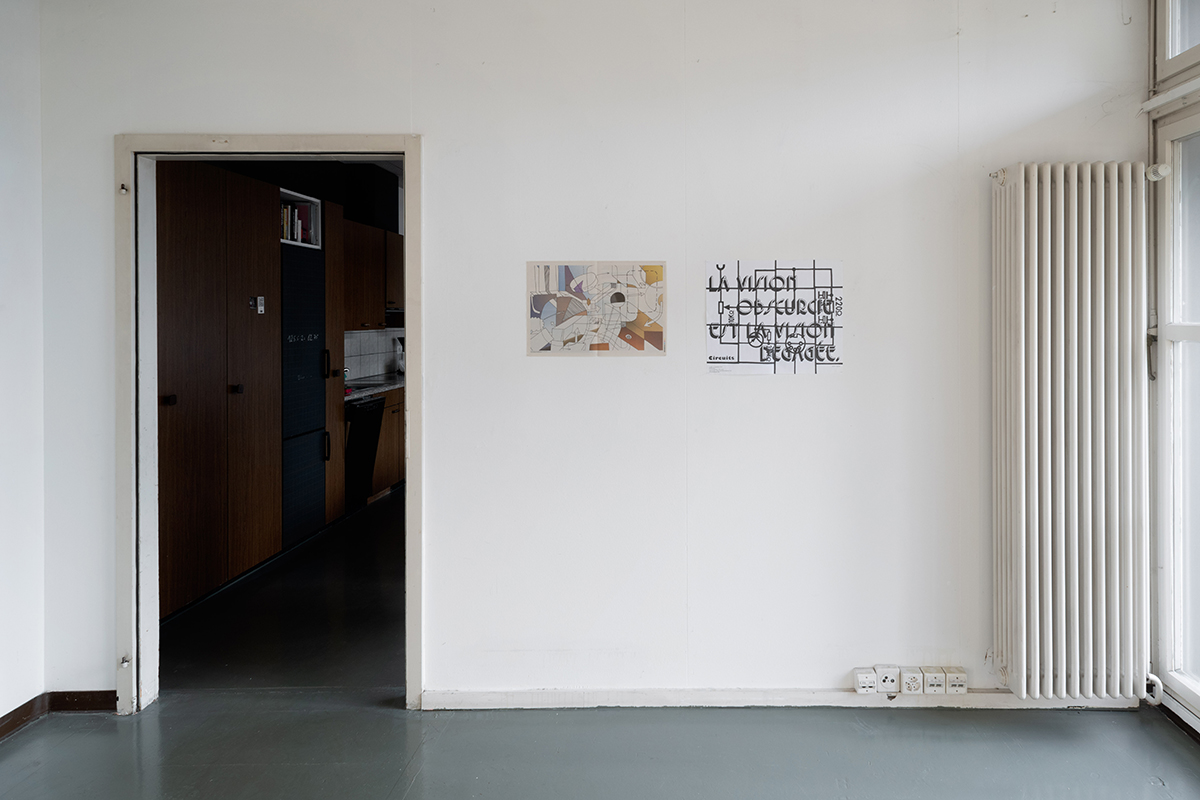
What cannot be seen, or has barely even been proposed is a second "cultural" turn. With Steam Engine I was starting to consider bringing back the Cultural Studies of Raymond Williams and Stuart Hall. Cultural studies was one of the hot theories of the late 80s in the art world. But before that dumbing-down, Stuart Hall occupied an incredibly interesting space between post-colonial critique and an immersion in the immanent media cultures of the post war period. But I think there is short cut in the underpinnings of these two writers and their followers' theories. This may be based on a misreading of what value is, a fetish, and how this is very different from a goal of seizing only the relations of production. Even as they privileged the fetished relation of cultural production, they did so based on a misreading of economic relations, which are arguably themselves "cultural" relations.(8)
This could be preparing for a new political context, and anticipating it with a new cultural studies. Artists are so used to thinking they know what economics is about they assume that their cultural analysis is adequate to it. But if one is wrong then both are subtly wrong. And with some exceptions the current youtube view of Marxist economic critique is also a quickly-synthesised failure. Not to mention "democratic socialism", Novara Media, Jacobin, etc. But there was nothing wrong with Raymond Williams's idea of cultural studies - a structure of feeling of a coming reality - if it were now based on a more updated and rigorous analysis: a new cultural studies. Perhaps here the cultural field would be circumscribed. It would not hold that cultural production is a driver of political organisation, nor of course capitalist value relations. But it could indirectly describe these or leave a space for their description and it could thereby speak about what might constitute political solidarity.
I wanted to say something, but I do not really have time to characterise it or do much more research:
It could be tentatively proposed that since the 90s there has been a steady inching closer to a more accurate reading of Marxist value, both in activist and academic circles, and even the art world and other popularised forms.
Some precursors of this change were Michael Heinrich, Moishe Postone, Murray E.G. Smith,(9) Marxists who opened a space of understanding. I am not saying that they have a revolutionary strategy, they could be said to be rather academic, placing capitalist totality rather than a class war at the centre of their arguments.(10) But their projects looked at the deeper contradictions within Marx's own work. That the commodity is split in two, use vs. exchange, is well known. This implies that the commodity of labour is likewise split. The "...twofold nature of the labour contained in commodities", concrete and abstract labour – one a self-annihilating use-value and the other an absolute, abstract demand – is "...crucial to an understanding of political economy..."(11) The most developed kind of social relations, like politics and culture, are riven in two by fetishisation, "The fetish character of capital and the representation of this capital fetish...".(12) It is not any longer about taking over the relations of production but of changing the social relations behind and within commodification. Moishe Postone talked about "...value as an objectified social relation, that is carried by, but exists 'behind', the commodities as objects".(13)
Is this "inching closer" actually happening? Maybe I am wrong, maybe I'm describing it wrong, and perhaps things are even going the other way in terms of comprehension. And it is not the task of this press release. But if so, then my idea is that mere artists such as myself could start to move away from explicating building block issues such as surplus value and re-engage with the cultural terrain.
In late 2019 and since, as an experiment I have been allowing things to drift, follow no set pattern. There is not really a pathway for this. A kind of lifestyle drifting was popular already in the late 80s and I was even part of it; so not exactly that. Instead, following on from a more solidly researched starting point, a weirder drift.(14) For example taking out lighter books from the library (while understanding the agenda of the library), then following digressions and threads. It may have to be a drift interrupted by seemingly topical or perhaps identity political claims, that are not in fact interruptions, but guideposts. Culture in both its rarefied and wider forms has been shown to be bound up with a postcolonial process. There has been no "digression" in thinking about how to oppose British nationalism, or Trump – there are deeper contradictions being played out here. This has been the change, the churning we waited for the whole neo-liberal period. And perhaps this is what has been happening secretly for the last few years.
But what is this difference between that drift and a reproduction of the existing bourgeois context? There is a huge risk of a re-emphasis of cultural inquiry being once again re-integrated, as the original cultural studies was. Fetishising culture is as bad as fetishising workers: each technique of liberation is used to make money. And art especially it is often about painting and money.
The new cultural studies would be half-visible to capital, visible to a revolutionary future, invisible to yesterday's cultural revolution. It is not clear how this realised, but I suggest through a fundamental splitting of the object of study. The new cultural studies is introduced as a doubling from the very outset, in its ostensible natural appearance and its concurrent voidedness. It mirrors the lack within labour, the "value-objectivity"(15) standing against those "external" functions which are memorialised only as the gaps in a broken circuit. As such it speaks directly, analogically, to the conditions it inhabits and can "work" with them. Once that background Marxian engagement has been thoroughly understood, something shifts, a split is built into the working practice. To bring in Lacan (and this is not an endorsement of his neutralising clichéd role within the art world, but using his words a bit against the grain), "...the problem of identification is linked as an inherent psychological splitting..."; and, paradoxically, out of this splitting, a quasi-object can emerge: "It is through this mirage relation that a notion of the object is introduced."(16) Culture's very maleability, its fictiveness, makes it a strangely fixed element within capital's even more fluid recomposition process; fluidity a weapon against fluidity, to step back in time. Lacan speaks of a kind of cultural object: "At the level of sublimation the object is inseparable from imaginary and especially cultural elaborations. It is not just that the collectivity recognizes in them useful objects; it finds rather a space of relaxation where it may in a way delude itself...".(17) This revenge of literalness destroys the tension of an "art exhibition", embodying its own invisibility. The invisible object of Alberto Giacometti - the living object.
Nevertheless I should also be on my guard against Žižekian, neo-Hegelian or speculative realist fantasies; blown out press releases and Lacan's reception are being doubled too.
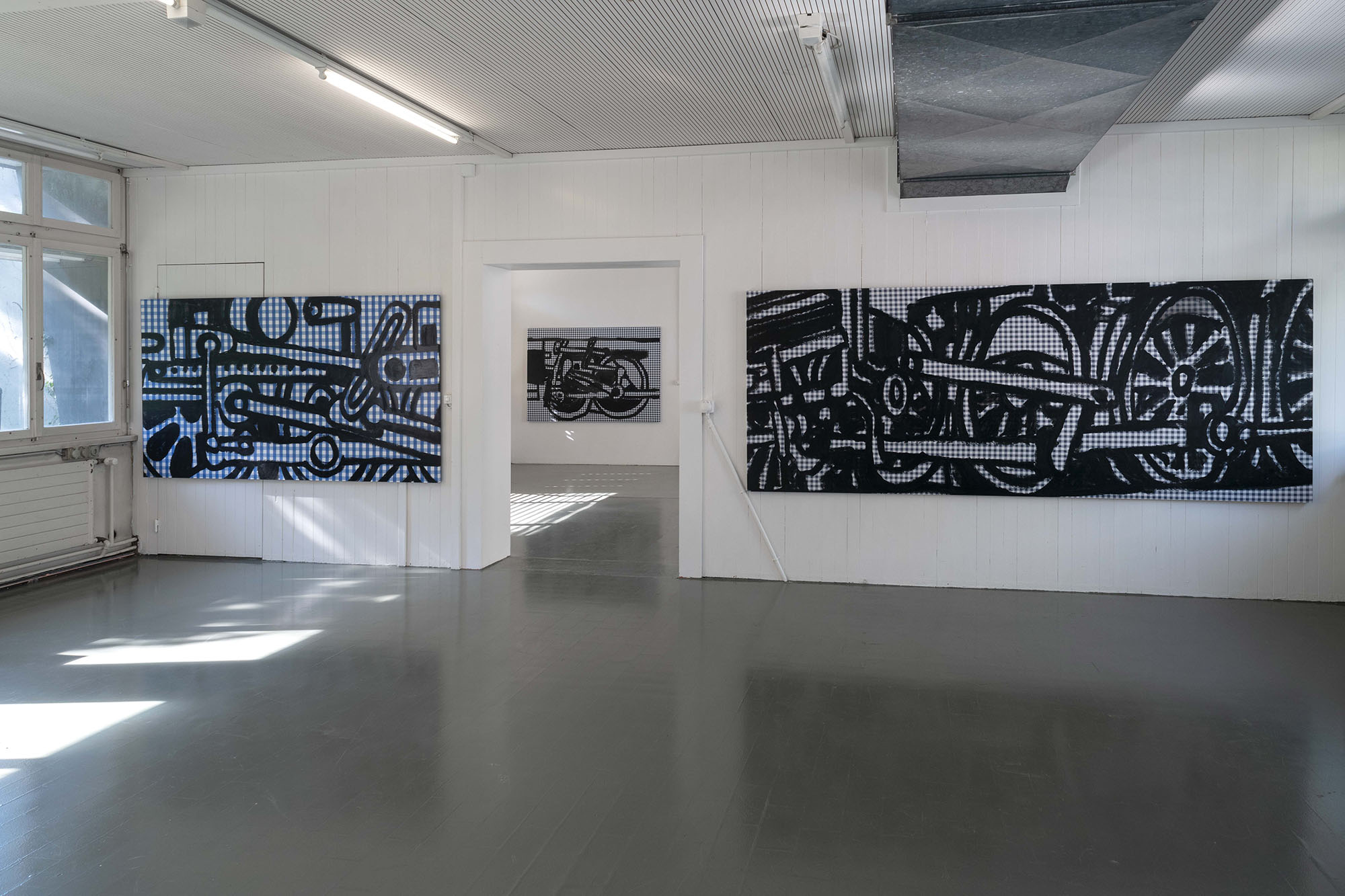

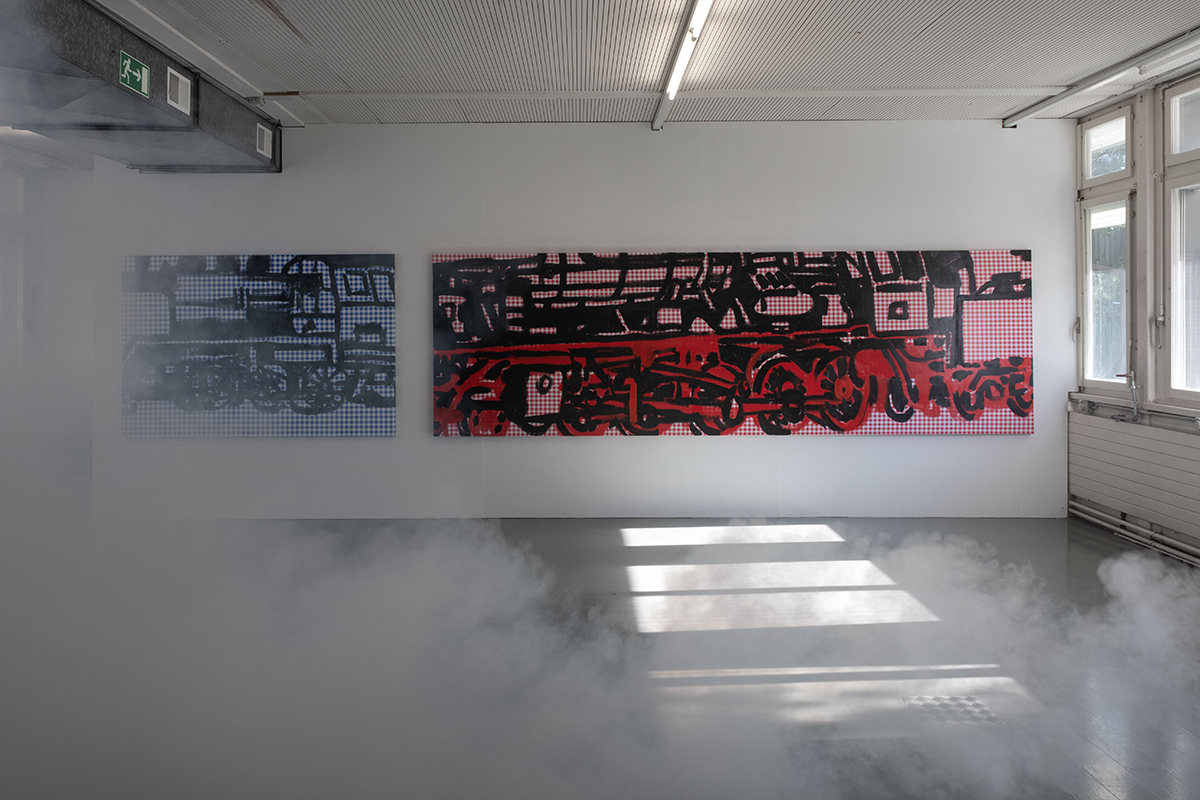
I have already questioned whether observing and accepting the disconnecting "jumps" in the diagram in motion could be itself a far right move. The fascist caricature of a capitalist diagram captures its other, making forms out of symptoms and making jokes real. For example, Trump turned the idea of "fake news" from a criticism of him to one of the mainstream media. And this very notion of "mainstream media" was stolen from the left. The Far Right in the Art World partly means those who embraced Trump or started to strategise for his permanent rule. The story of this turn to the far right has not been told. I drew a diagram of the far right in the art world in 2019 but in the end I left out the names; it might be good to put them back in, or at least say there were some. They will re-emerge when Trumpism does. The far right also just leads to the right: some of the participants marked as "far right" are just in fact ultra-conformist reactionaries, or even just radicalised centrists.
The return of art is already far right. For Samo Tomšič, "...culture is... resistance against critique..."(18) Unmediated "culture" veers to the right, via all the hurt, pain and disappointment the producers feel, the "I'm not getting what I deserved". A vague paranoia which I am fully aware of, as I experience it. A certain stubbornness, not any new turn but more of a residue, becomes an image, and because of that it is graspable. What can be grasped is a weapon for the far right. Anything that is just the urge to culture can be turned right, and likely will be. The art world tries to move, but in its urgency to move it moves in the wrong direction. Incorrect theory leads to corruption: in the rush for solutions platform socialism becomes the structural exclusion it decries.
It is necessary to change levels here. Perhaps this kind of false turn, or misunderstood view, is exactly the kind of thing that lends the diagram the appearance of a peculiar jerky movement. There are stops, or gaps, which appear to form a complete diagram but are only value's distortions of wider relations. "...The notion that time has come to a standstill, the idea that the wheels of economic progress have stopped turning provides an interesting gloss on the zeitgeist, but it does not provide a compelling analytical frame."(19) The frozen snapshot view of the early pandemic period was also an illusion. The view becomes a short circuit. Superficially, the "vertical" viewpoint is great, and for recent geographers like Stephen Graham adding a vertical axis has been a breakthrough.(20) Yet the huffing puffing "view from above" can be read as a forcing of the issue that in fact speeds up the distorting engine.
It might be more useful to see the seeing itself, to see its own distortion. Consciousness of these dilemmas traces them as models. For Steam Engine I found myself using with artistic licence Moishe Postone's concept of "value in motion"(21): "Value is a category of a directionally dynamic totality".(22) Once the diagram is moving, "seeing" it is also just part of the cycle, and the top down distance this seeing involves itself a distortion.
There are two doublings: that of the broken diagram, but in motion; and that of "seeing" the diagram. However because that seeing is a snapshot in time from a false perspective, the seeing itself needs to be seen. These two doublings revolve around each other. A barring of the thing that the viewpoint tracks, this thing also being a barring, a value barring. For example: a symptomatic resolution, as barring, this pseudo-resolution restricted to being about, and contained within, the art world. A working on the ambiguity of whether this (negative) content is actually "there" or not. The point of understanding is a non-place, the connection being that there is no connection point.
You can't offer an alternative value structure without questioning the structure of value. An array of individual choices does not change anything. "Change" does not change anything. Whereas the view of the view from above is the change of change, a change of system. Naming the wider frame, naming the movement as a static flow, a repetition that might as well not be moving. According to Moishe Postone "...Abstract time does not express the motion of time, but constitutes an apparently absolute frame for motion; its equable constant 'flow' is actually static."(23) The search for this meta change – as echo, or seemingly fixed form – is a special kind of negativity. Its regularity of motion is what differentiates and marks the negativity out, but it is not clear exactly what sort of differentiation is able to achieve this. Probably the critique embedded in 70s cultural studies did not really do it, nor the Adorno-like transhistorical negations or the Marxisms of that era. The question is then how to find a deeper, secondary cultural pattern: "...the historical flow exists behind, but does not appear within, the frame of abstract time".(24) What I am tentatively imagining is reverse-engineering a picture of connection – relations "controlled" by the knowledge that it is they that comprise the moving diagram's shadow. A practice in relation to its mirror image in econo-cultural reduction, one which has something to compare itself to. It is a negativity grounded in the organisation of the struggle against value relations, but its grounding is in the ungroundedness of this organisation.
Value is "...a category of efficiency, rationalization and ongoing transformation"(25) –and its continuous reconstitution. To track this, cultural studies must be in motion just as its object is in motion; two parallel motions in an interminable analysis; a bifurcated split. The double barrings of motions and observation reflect each other in a symmetrical pattern. This suspended position holds that view (of the already double nature of the diagram in motion) at one remove. It asks from where to see the transformation process. Flow diagrams in flow; so far this is far right, but the view on this – that views itself as doubled trace – is not.
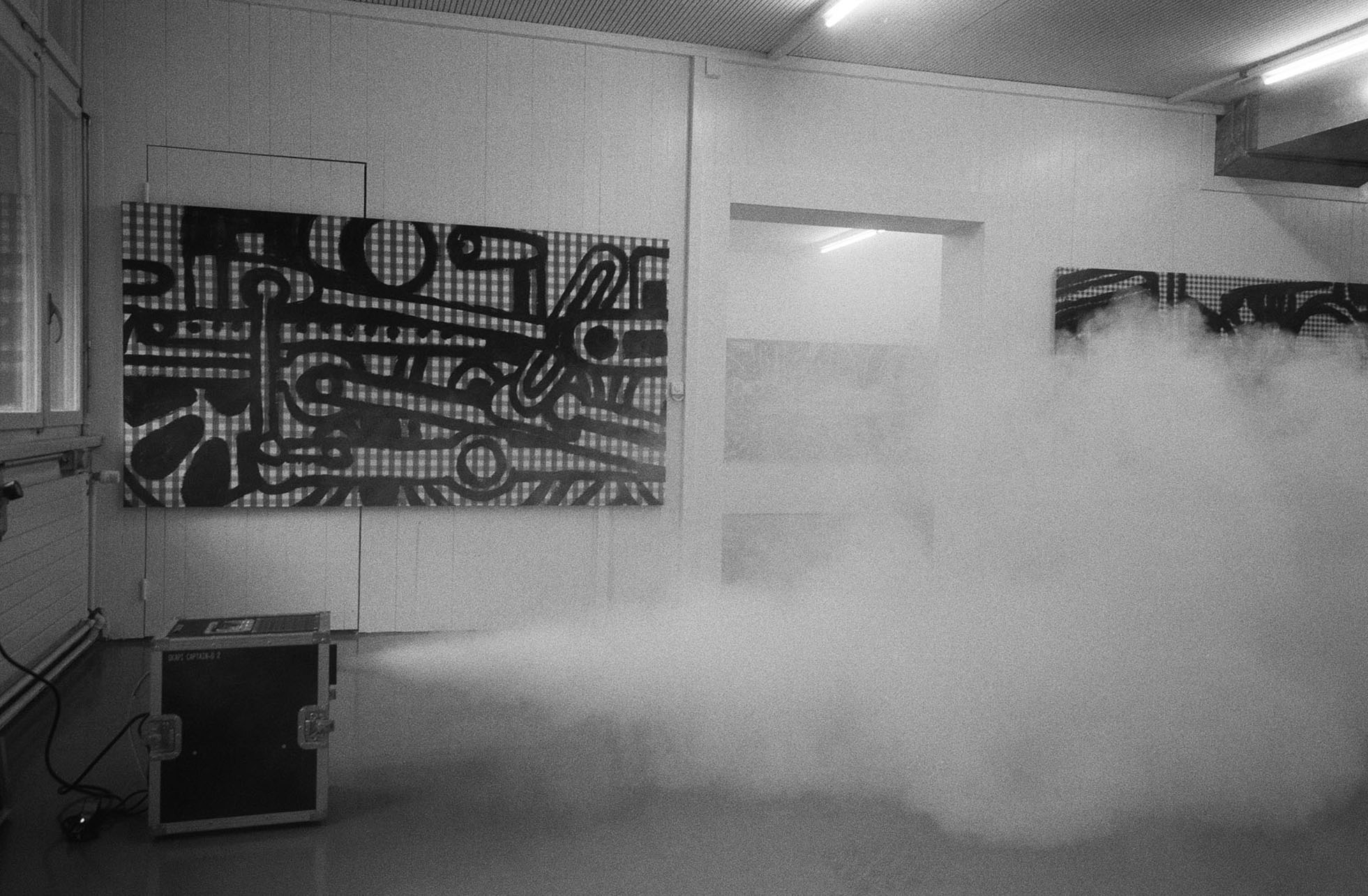
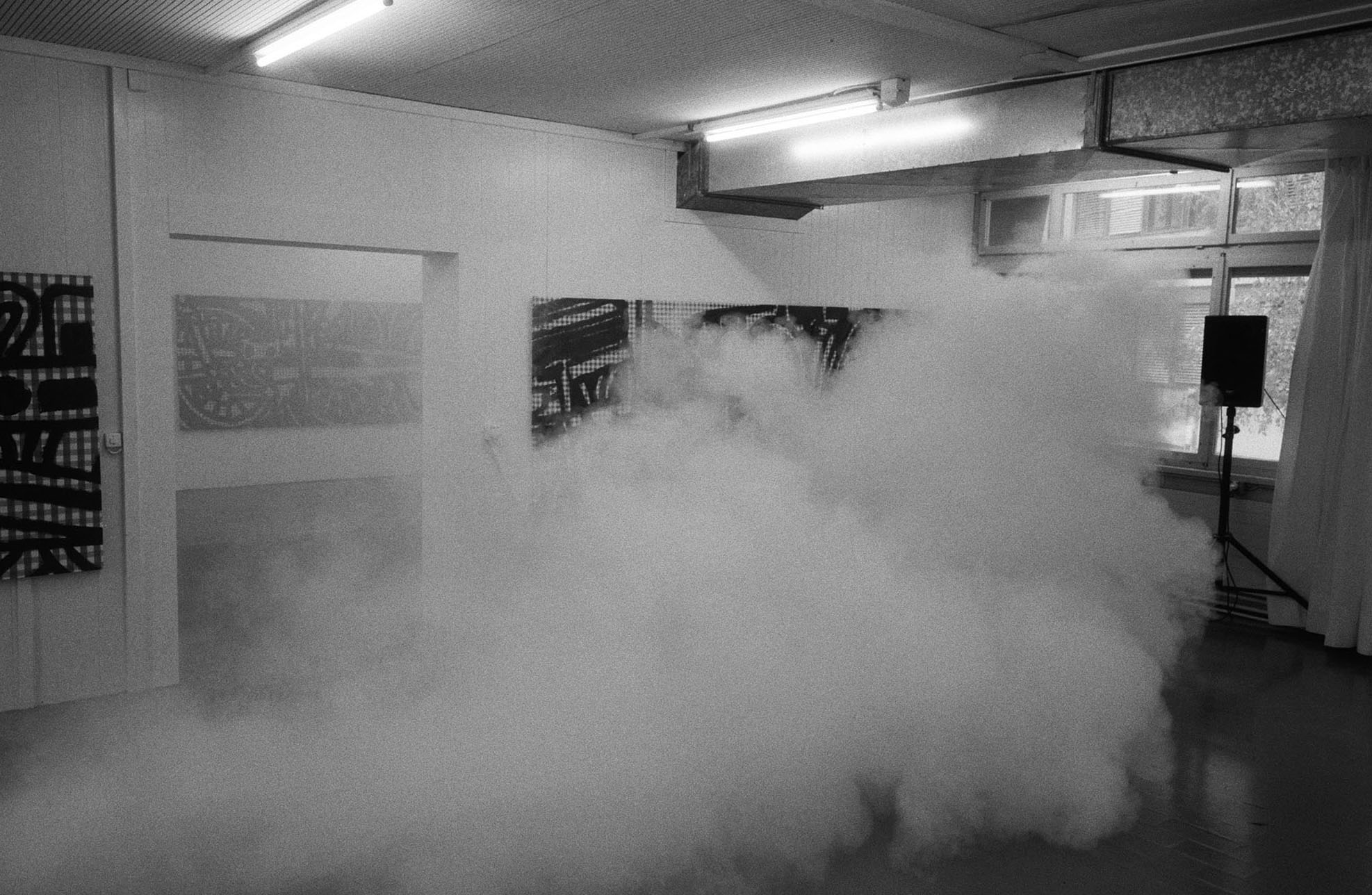
How does this relate to painting? Why did I have a work in Steam Engine that looked like a painting but is called Beyond Painting?(26) What are the persistent ur-ideologies of the painters and their apologists, and why are they so stubborn? Behind the lurch back to painting is the empty space formed by class struggle. To spell out this empty space is to make a right turn. Like a steampunk storybook, painting surfs off the abstract labour it conceals. For artists, a classic mistake is to do things in their "own previous style" that now means the opposite of what it once did. There's a painters' pseudo-enjoyment inherent to this. And recent shocking crises, which seem to demand instant reactions, push internet autodidacts starting from a vaguely leftist self-consciousness into further error. Creatives or creators desperately try to picture something and an accidental parallel diagram emerges, the intentions not their own still secretly in thrall to value. Beyond value they do not model the post-capitalist, just a distortion of post-capitalism, a value distortion popping up on the surface of the capitalist circuit.
The inevitable train wheel-like motion of the fake diagram is actually ideology changing use into a new use. Use-values are not use-values, they are use-values for exchange. Are these codes "outside"? For example subjectivity itself is a specifically capitalist use-value. It is a political battleground within the movements of the diagram, because subjective forms are themselves determined by these diagrammatic constellations. These forms in turn re-arrange the circuit. The existing social is a symptomatic, aesthetic/cultural use-value producing further capitalist use-values which are equally overdetermined by economic form. "Subjective" affects in painting are examples of tarnished use-values or externalities.
Those who reckon that painting speaks the unutterable, and thereby want to rescue art, offer easy solutions drenched in ideology. Even when this art is speaking in some updated format, from zombie formalism to figurative formalism.(27) The reason I didn't put out a press release in Zurich was not because I was bowing down to that which must remain ineffable. In fact I was just deferring an unutterability that was secretly still completely sayable. These are two extremely different positions, but they're close enough to make it important to spell out the difference. There is a conflict going on between those who want artists to be a nice painters, and artists like me just pretending to be a nice painters. But within that pretence comes out some fairly wild painting. Necessarily, the role of outdated "anti-painting" from the 80s is finally totally reversed, as had to happen. Anti-painting had to go full-on-painting in order to allow the tracing of a double-diagrammatic borderline. The border is a stronghold, because there is the stronger connection made when there are no connections to be made. The border stands for an internationalist class line not for State artist criteria or approval. It is painting and not: painting is only a marker of a wider "painting", that is, the whole edifice built from a collective view on our lives, desubjectivised intentionality and friendship anti-networks.
This is not a return to artistic freedom, but rather is intended as a move into hybrid "prog" ways of working (I mean by this word in the sense of elaborate "progressive" rock music). A return to the cultural terrain, proved by the fact that this is not possible: a "...non-objective form of social mediation...".(28) This mediation is an intensification not a reduction of anger; a point of access, sneaking past the border guards of a social trust circle that preserves dated edgelordism. The fact is that unwittingly right-wing friends, AKA scene marketers, are always very close. Fake "surge" hipsters try to colonise the newly introduced "prog". When this happens the social scene will be deliberately split once again.
Static crisis is the norm, it is the cultural form of capital. In a world beyond human control, any control system is better than none. Perhaps a system of sweeping inward changes, the trackable inner world – the self-logging process turned against the edgelords – is one attempt at this. The lead up to it is it; dream and real overlaid. The machine can only be pictured through self-overlaying cultural drift.
I paint-it-myself, in my role as a doppelgänger or typical "other person" that seems to do the paintings for me. In this character's "other" singularity, a collective averageness describes affects as structure. Lacan dismissed affects which "...do not throw light on the economic or even dynamic essence which is sought at the horizon or limit...".(29) Affects are not unique but typical. The experiential is not experiential, it is the wider analysis that is experiential. Or, more specific to this moment, I paint a painted description of right wing painting, this is as a model of itself. It gains an autonomy within non-autonomy arising from the correct reformulation their actual relationship, exposing the content of previously-mentioned ideological "empty spaces". The unthought void is replicated and displayed, through exaggerated weirdo painting and out the other side.
This is why a press release is now coming out. Although in Steam Engine and some previous shows I admitted that painting has moved on, and is very different in terms of style or methodology than when I was young; nevertheless a specific position remains tethered to it inside-out. But if I had remained in the old institutional critical anti-painting format without any acknowledgement of this change of emphasis, my work would also have been veering right, because an anachronism starts to mean its opposite. 90s institutional critique in its original form is now far too close to a simulation of itself, it could almost literally be done by a computer, and if so is likely system-supportive.

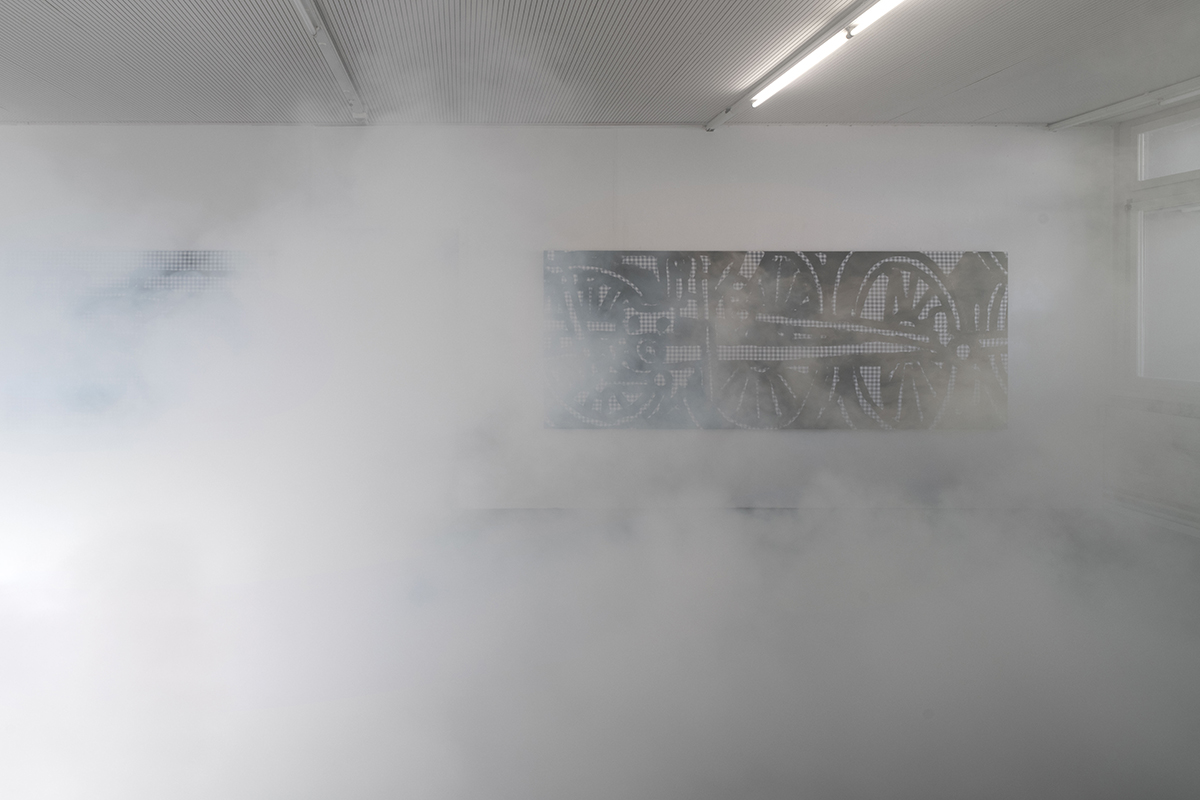
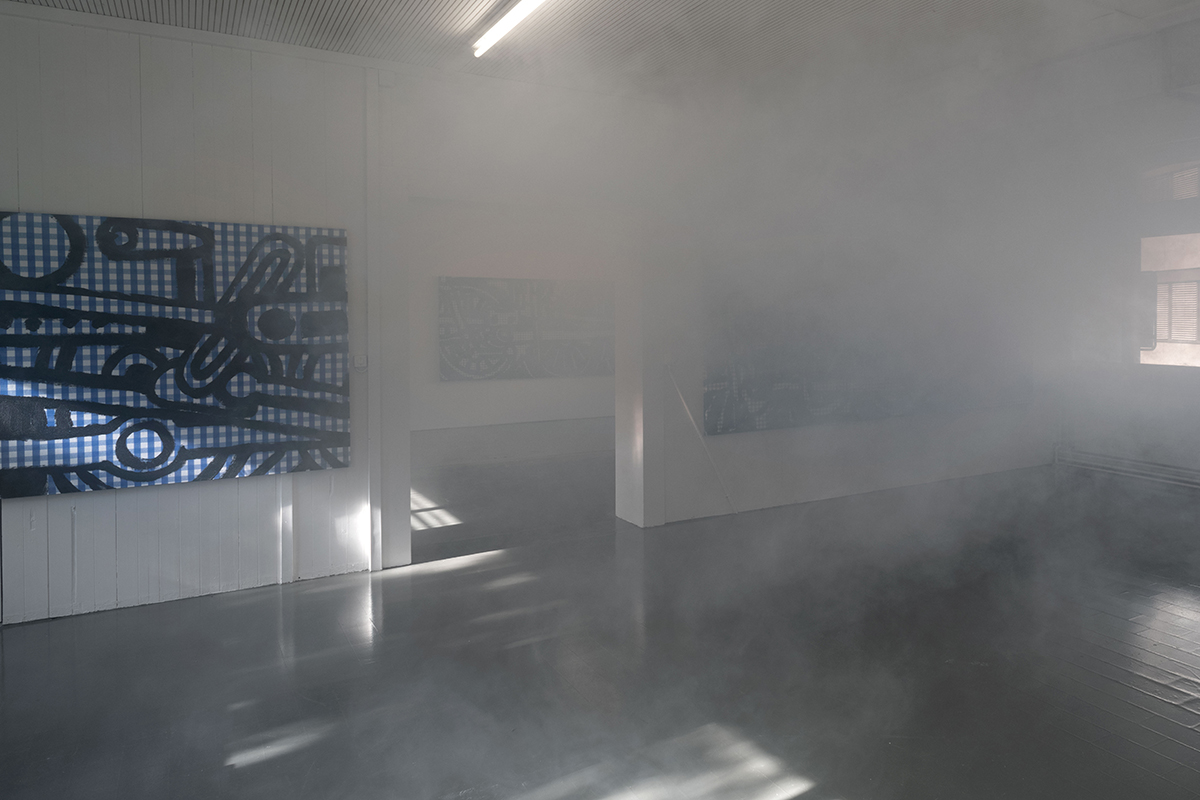
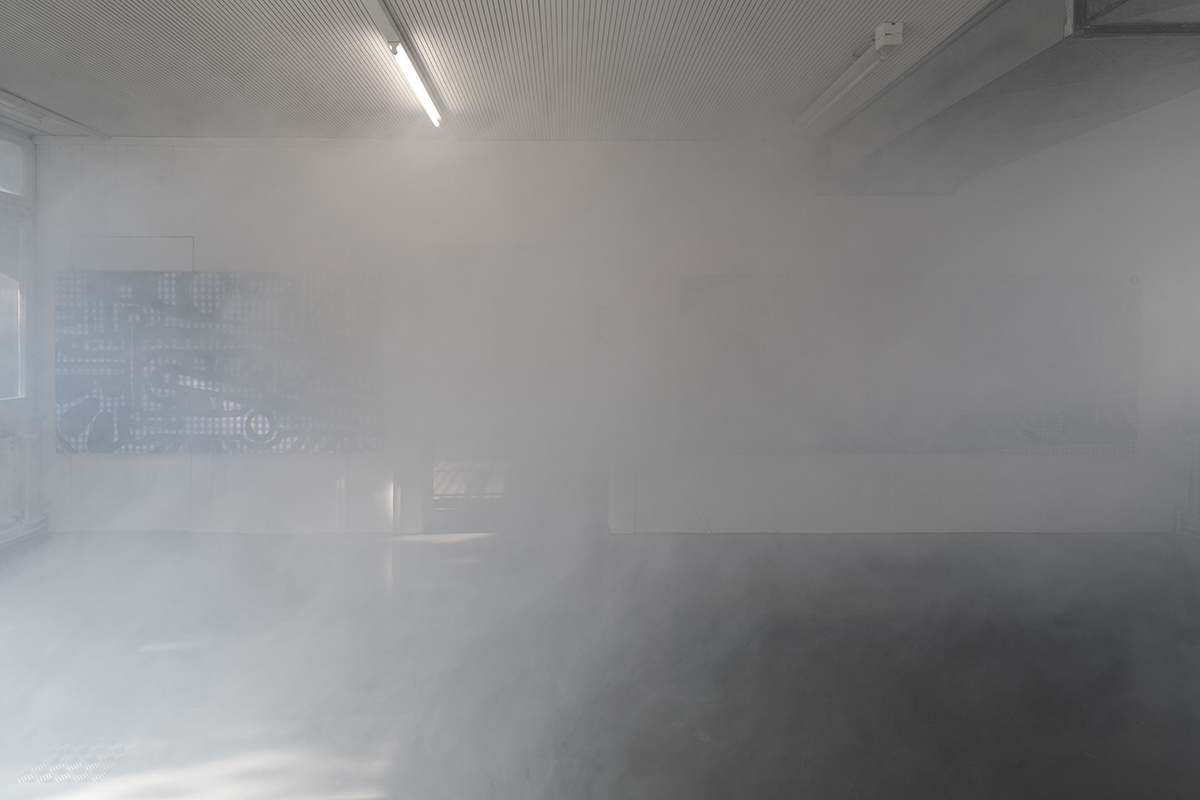
I search for an artist on Instagram.(30) But I don't see the artist's work, I see Instagram itself, Instagram the platform. If Instagram has gained role as gatekeeper, the art world has lost it. There is no art world. The art world gave away its platforming function. Most art discourse is a self-reproducing loop that creates its own characterisations of itself. It is a remnant.
The way Instagram structures the art world could be a turn to the far right, part of a process of the instrumentalisation of networks. Art post conceptual art was basically information, and part of this information was how it was communicated to groups of like-minded artists. This has made it porous to corporate attack. Both the repackaging, or "nuggetting" of this information; and, more decisively, the decisions about the recipients (who they are and how they connect with one another) have been overwhelmed by the algorithm. Both questions are inherently political, both have been neutralised. That's not to say that the older art world wasn't an evil portal which was attempting a similar hijacking. It was pretty awful. But now the tech world has stolen this already compromised portal and accelerated it. Instagram capitalises networks and naturalises a process of conflict, moves the line of composition to a mystified grouping in a new and more condensed form: all information goes through a single gate.
My experience of pre-internet art was that it was quite dismissive, little guidance was given or needed. It felt like this: I am the problem, I am the analysis, I am a kind of social media: my work is already the text and an artist's name should not be a brand. A layer of branding did not make sense as the line of fine differentiation went all the way from macro to micro, there was no official and unofficial layer, and small decisions counted. But now I am a social media story, and not of my own story but of a corporate narrative. Whether I use their services or not, their story about me is me. Though it also promises a kind of infinite regress between life and art, Instagram does not promote an understanding of this process, nor enable the construction of worlds. Likewise, most contemporary left politics is pro-capitalist, as it is embedded in capitalist platforms. Links are the underpinnings of compromise – getting "LinkedIn" is what you do when you have no choice. And that kind of forced labour undergirds the real. A bit like understanding something, then falling back "into it".
Meanwhile the social media platforms are also already breaking down. I could almost imagine Instagram only being used by the art world and related industries by this point. What is increasingly clear is that if your business depends on a single platform you don't have a business when that platform dies. Instagram-type social media could also be seen as a pre-enclosure of the traces that a future society will use to recreate a historical model of the present. And of course they censor as well.
The Steam Engine works were always about social media, and art can currently be about little else: the diminishing returns of shitty self-promotion and self-gaslighting. I'm not rejecting the inevitable social media reorganisation of human communication, I'm for an experimental model of a second social media, arrived at in a moment of supernatural crystallisation, fake synthesis. There must be a way back into the platform itself, to be able to describe it as it walls out. Social media brings you right to the edge of your own silo. But your reverberations do not penetrate the outer wall, they are only shuffled within. What would penetrate the edge of the silo? Somehow to inhabit the platform of platforms, a bigger socialisation.
Totality is mediation, the political redefinition and fixing of culture. The work itself is communication, in a counter-revolutionary environment. Revolution is in the definition of a platform, of social media.
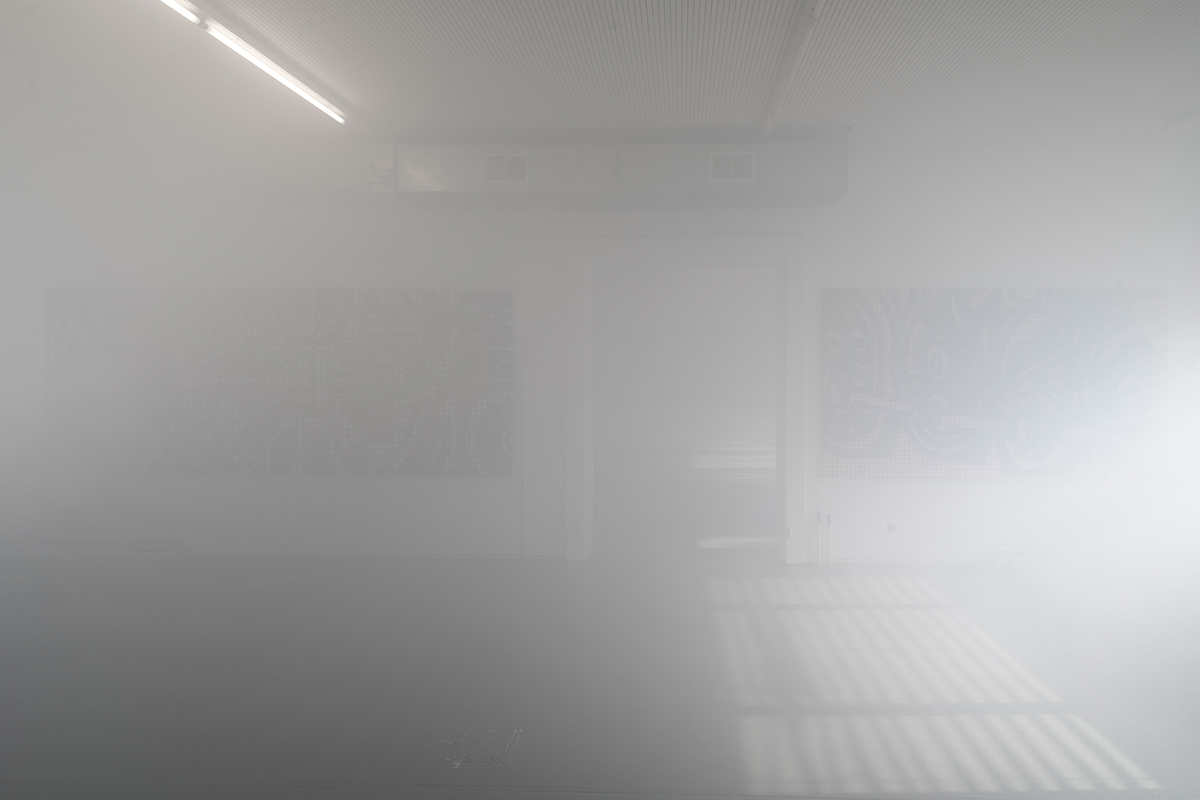
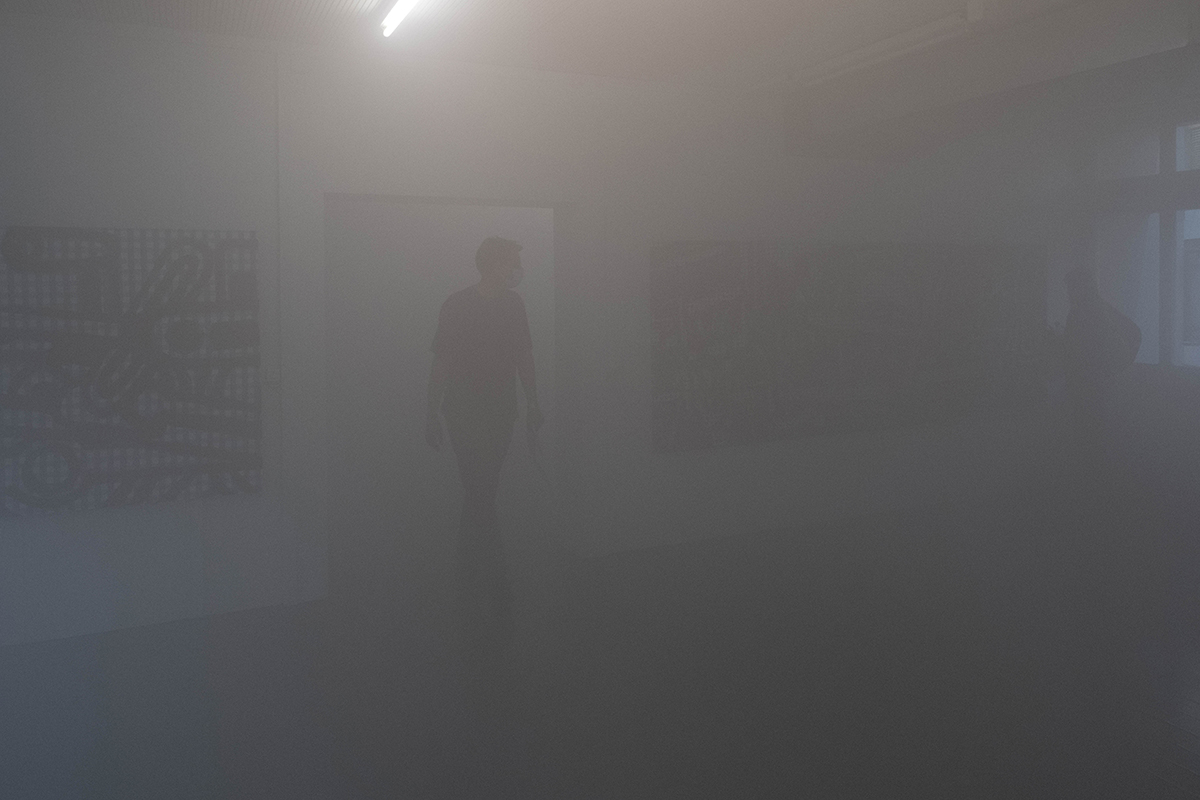
One avenue through which to march this question might be just the intensity of stress. Unbearable stress itself the sense, the solution, hidden behind the feeds. The so-called news is not the news, anxiety is. Anxiety is the truth, social hysteria the norm, and brain fog the in-common. So, contrary to the instinctive response it's better to try and stay in the crisis, and not try and leave. The shared reality is only visible in the extremity of a shattered debate. People ask themselves how to hold on to their thinking. The answer is to stop holding on, let yourself go: the future lies in the screaming abyss. The mental health crisis explains the crisis: burn out, the typical pandemic illness, is a response not a breakdown, and potentially a collective binding. In the centre of anxiety there is no pain, pain is everywhere except where the pain is, where the economy of pain breaks down, where there is relief. Here the rules of risk are re-arranged: it is more risky to get out of the crisis than to stay in it. Conflict is embraced through its lines of mediation, and on the other hand mediation and repetition ameliorate conflict. This becomes a negative model of organisation that dare not speak its name.
Though in theory diagrammatic, vector-object-like renderings on a grid, these locomotive wheel paintings actually have thick, rough lines, and are painted on plastic tablecloths. Trains were also rather crudely called to mind by the music coming through on the PA speaker system. Despite this, such crude contents do not call a halt, but structure flow. They are not concepts but mute staging posts in the creation of a critical continuity in the face of capitalism's impossible inclusion. "...A distortion or minimal displacement, which splits the pragmatically directed action from within."(31) Dealing with these contingencies is the narrative "between": the safest place to hide is within your spilt self, disguised from your friends.
If, for Samo Tomšič, the symptomatic is equivalent to the revolutionary,(32) then the task might be to organise a symptomatic map. According to him, Lacan or Melanie Klein, the capitalistic circuit is reflected in a psychoanalytic circuit – although Freud himself surely left much more of a barrier there and perhaps with good reason. But let us say, only as metaphor, that the unconscious realm finds its reflection in a flat circuit, this being made up of the random pickings the conscious mind makes of it according to a methodology of minimum effort: "...to allow with the least movement all those departures that are individualized as attention paid to this or that chosen point on the circuit...".(33) At the moment of comparative overlay of the psychoanalytic and capitalist circuits, the circuit in motion would merge by freezing into a functional template.
But what is it? A "trace" has been suggested before, as a self-building demarcation line that for its functioning cannot become too defined.(34) What makes this a trace is that it refuses to locate the layer it is positioned within: "...that which one seeks and finds again is the trace rather than the trail...".(35) The trail is too distinct, an ink pen line. Steam Engine did fail to demarcate, as Arthur Fink helpfully misunderstood in his review.(36) Does putting out this press release text make it all too clear again? If the demarcation in the form of reintroduced content is too obvious it may easily fail to demarcate.
Yet, as before, any culture will turn right unless it is marked as unturnable – and this mark of negativity is class struggle led from below, an active part of a revolutionary process and a correct theory. You need to be a communist in order to demarcate this line; it is a revolution translated through its own revolutionary conditions, traced in air by political experience.
Steam Engine is suggested as one precursor of a much more overdetermined negativity than that which underlay previous cultural studies, a negativity which prepares culture after a revolution in value relations. The layers, the echoes, the archetypes. Repetition as trace, its negativity is constitutive: things happen when you don't force them. But for who? For force itself, from one state to another – not a translation of a fixed state, but a machine with which to cancel itself. To acknowledge this thickly driven contradiction is pulling itself to pieces is to accept that non-identity is the only bond that makes sense. Disidentification as solidarity. Collective action starts with a contradictory and dual self-awareness; first the self as pre-clichéd subject. This divided subject then further sets itself against a matrix of similar activisms: content is "projected" through an assumed regularity, of audience mind meld, cocaine influencers and reversibility. Down two rabbit holes simultaneously, a double exiting of experience. A blank unresolvability that contains a savagely split content. Any reaching for neutral forms not marked by this double contradiction is dangerously mystified.
My analysis has not been looking to escape the boundaries of the middle class artist but see what the replication of the consistency of my own position can offer. I know this fails to meet the wider struggle, yet the existence of a double register in my opinion registers a coming reality of what actions might make some kind of "abolition" happen.
That is why there was steam at the opening. It's the vagueness of the positioning in relation to the diagram, showing through which fugue gateway to insert the trace.(37) The wash of a secondary negativity is required for this crossover. The locomotive is boiling at 100mph. This is a representation from the machine age, but this is just a nod. The steam obscures, and so reveals, the hiatus when the diagram in motion can be witnessed before reforming into a new mystified circuit. And the steam places the viewpoint itself into a deliberately mystified context, this "view" is also a narrative. It is only by making the top-down view of the diagram in motion into a part of this diagram that the whole thing can be glimpsed. If the vertical snapshot is a view within views it is not fascistic. It is in the interference pattern between two maps that the steam clears.
The entire space is structured, including the space which sees it. This is a view of the second circuit, a secret diagram of a moving model that borrows from amnesia, anxiety and burn out, leading to a new cultural studies as the view back onto culture from the side of abolished value in 100 years time. If we are looking back from future relations of production, and not forward from the past relations, a different object emerges. For now, there is a view obscured by steam. The view onto the diagram is constrained. The steam is marking the non-place within this constrained view. Steam is dye, it traces the invisible trace: four-dimensional structures which are modelled by gas. The gas shows the process, like symbols in motion on the surface of a membrane, but this membrane is in three dimensions, and what is being represented is in four dimensions as it is in motion. The (dyed) trace of the trace is more material than any material reality. In the unconscious, deletion has never existed – the only persisting tangible element is the truth disclosed once in a flash of illusion. Social media seems like the real; but its reality is negative, a whole, or a blank data storm. This hollowed space is steam, surveillance is turned around, made into the medium – the in-between; the flow in the centre of the river; the relations of relations to which this press release binds me nevertheless.
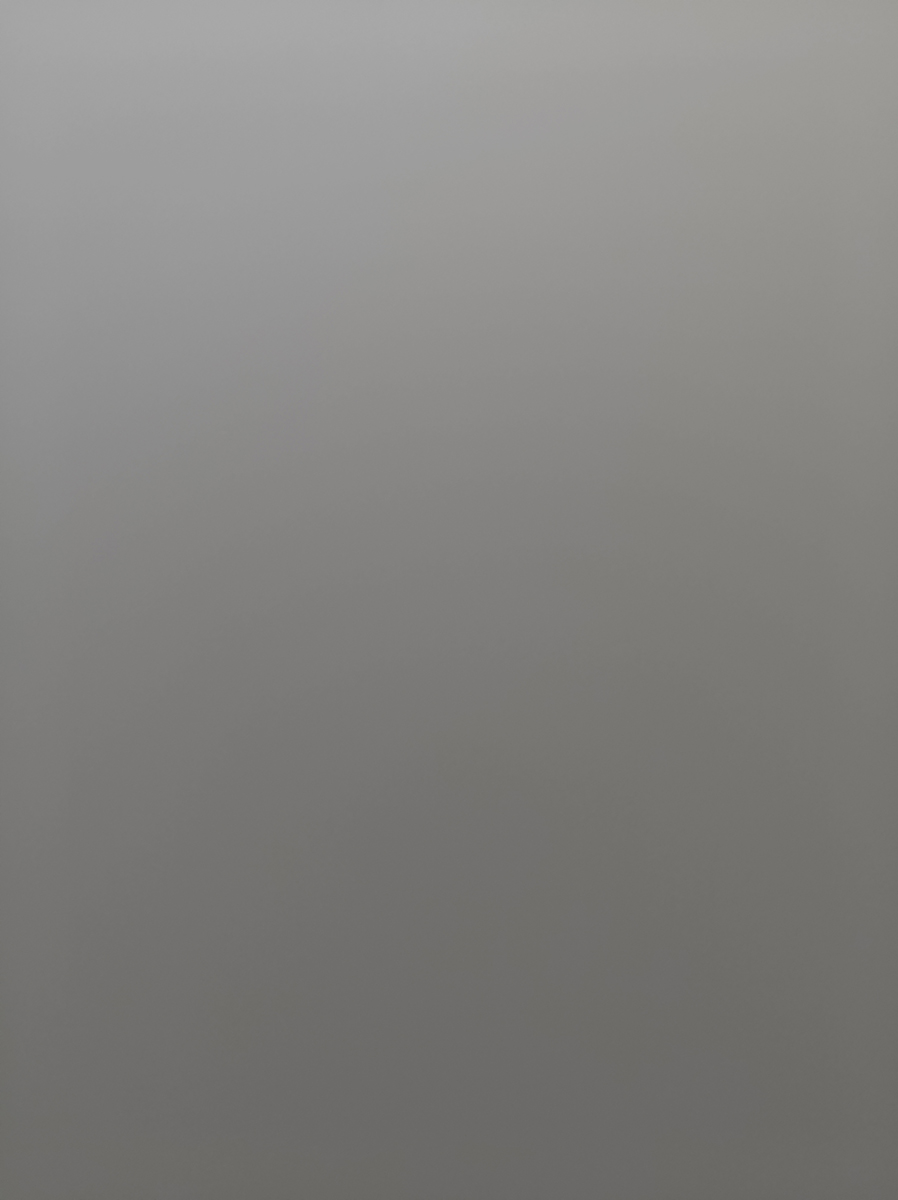
Notes:
(1) https://www.youtube.com/watch?v=WptTm-6IgjU, show dates 18th September - 1st November 2021.
(3) But Acolytes had not intended this.
(5) Poster insert for Arts of the Working Class, No. 6, Berlin, 2019, and the exhibition poster for Circuits at Palette Terre, Paris, 2020.
(6) See also Burberry Propaganda Tour 2013, https://factoryoutlets.tumblr.com/.
(8) As far as I know both Williams and Hall tried to broaden the definition of "culture" from validated art works towards working class communicative or leisure activities.
(9) Murray E.G. Smith, Invisible Leviathan, Haymarket Books, Chicago, 2019.
(10) Thanks to Sam Lewitt for a few suggestions like this one.
(11) Karl Marx, Capital: Volume 1: A Critique of Political Economy, Penguin Classics, London, 1990, p.132.
(12) Karl Marx, Marx's economic Manuscript of 1864-1865, ed. Fred Moseley, Haymarket Books, Chicago, 2017, p. 493.
(13) Moishe Postone, Time, Labor, and Social Domination: A Reinterpretation of Marx's Critical Theory, Cambridge University Press, Cambridge, 1993, p. 269.
(14) See also Manuel DeLanda's "genetic drift" as mentioned in "The Outside Can't Go Outside", p.15.
(16) Jacques Lacan, The Ethics of Psychoanalysis: The Seminar of Jacques Lacan Book VII, Routledge Classics, London and New York, 2008, p. 120.
(17) Jacques Lacan, p. 122.
(18) Samo Tomšič, The Labour of Enjoyment: Towards a Critique of Libidinal Economy, August Verlag, Berlin, 2019, p. 22.
(19) Lisa Adkins, Melinda Cooper, Martijn Konings, The Asset Economy, Polity Press, Cambridge, 2020, p. 90.
(21) Moishe Postone, p. 269: "Capital, then, is a category of movement, of expansion; it is a dynamic category: 'value in motion'. This social form is alienated, quasi-independent, exerts a mode of abstract compulsion and constraint on people, and is in motion. Consequently, Marx accords it the attribute of agency."
(22) Moishe Postone, p. 272.
(23) Moishe Postone, p. 294.
(24) Moishe Postone, p. 295.
(25) Moishe Postone, p. 272.
(26) Painting titles: Institutional Turn, 2019; Mind Intruder, 2020; Beyond Painting, 2019; The Far Right In the Art World, 2020; Value in Motion, 2019. Social Media, 2020; Trainwreck, 2020; Thomas the Cunt Engine, 2019.
(27) For "figurative formalism" see http://www.merlincarpenter.com/Merlin.Carpenter.PR.2020.pdf. And later "zombie figuration": https://www.artnews.com/art-news/artists/figurative-painting-zombie-figuration-peter-saul-surrealism-1202690409/.
(28) Moishe Postone, p. 361.
(29) Jacques Lacan, p. 126.
(30) I had various discussions with Isabelle Graw about Instagram, early 2022.
(31) Samo Tomšič, p. 137.
(32) Samo Tomšič, p. 247: "What exists is exploited subjectivity, 'damaged life', hence the social symptom, which is itself composed of multiple 'personifications' that change their appearance depending on whether we approach them from the viewpoint of feminism, the critique of political economy, anti-colonialism, structural psychoanalysis, etc. The labour of analysis and the labour of critique ideally have in common the attempt to mobilise and organise this symptomatic subjectivity into a (potentially) revolutionary subject."
(33) Jacques Lacan, p. 60.
(34) "In "The Outside Can't Go Outside" I wrote that "There is nothing wrong with using false conclusions for correct purposes, as long as this is clearly marked with an indelible trace."
(35) Jacques Lacan, p. 15.
(36) Arthur Fink, Kühle Semantik - Merlin Carpenter bei Longtang, Zürich, Texte zur Kunst, December 2021 No. 124, p. 142.